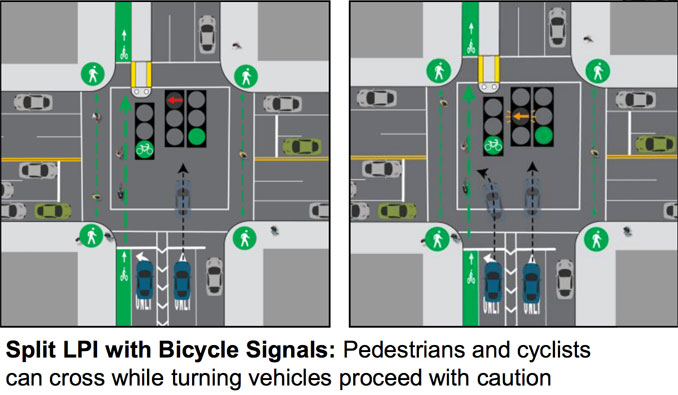One of the line items in City Hall's recent Vision Zero budget announcement devotes about $650,000 per year to "targeted safety enhancements and upgrades" in the city's bike network. Intersection design is one area where NYC is getting outpaced by other American cities, so we followed up with NYC DOT to see if we could get more details about this.
The agency says the funding will be used for staff time, equipment, and supplies to "implement upgraded intersection treatments along bicycle facilities, including piloting and studying innovative design treatments."
Currently, most intersections along protected bike lanes in NYC either have dedicated signal time for cyclists to eliminate conflicts with turning drivers, or "mixing zones" where turning drivers and cyclists negotiate their way around each other. Evidence suggests that dedicated signals are safer than mixing zones.
A third treatment is what DOT calls a "split LPI," which gives cyclists and pedestrians a head start, then shows drivers a flashing yellow to proceed with caution ("LPI" stands for leading pedestrian interval). DOT has put this type of signal at nine intersections along protected bike lanes and says the funding announced yesterday will be used to convert more mixing zones to split LPIs.
What NYC lacks so far are protected intersections, a Dutch design concept that makes cyclists more visible to drivers turning across their path and, on two-way streets, creates a safe route for cyclists to make left turns. There are now a dozen of them on the ground in American cities, including Chicago and San Francisco.
It remains unclear if NYC DOT will test out the protected intersection concept with this new funding, but it's an idea that could make a big difference for cycling. Elements of the protected intersection could be adapted for NYC's protected bike lanes on one-way streets, or as an alternative to bike boxes on un-protected bike lanes on two-way streets, where left turns can get especially hairy.
NYC is in the unusual position of playing catch-up with other big American cities on this bikeway design -- let's not fall farther behind.






